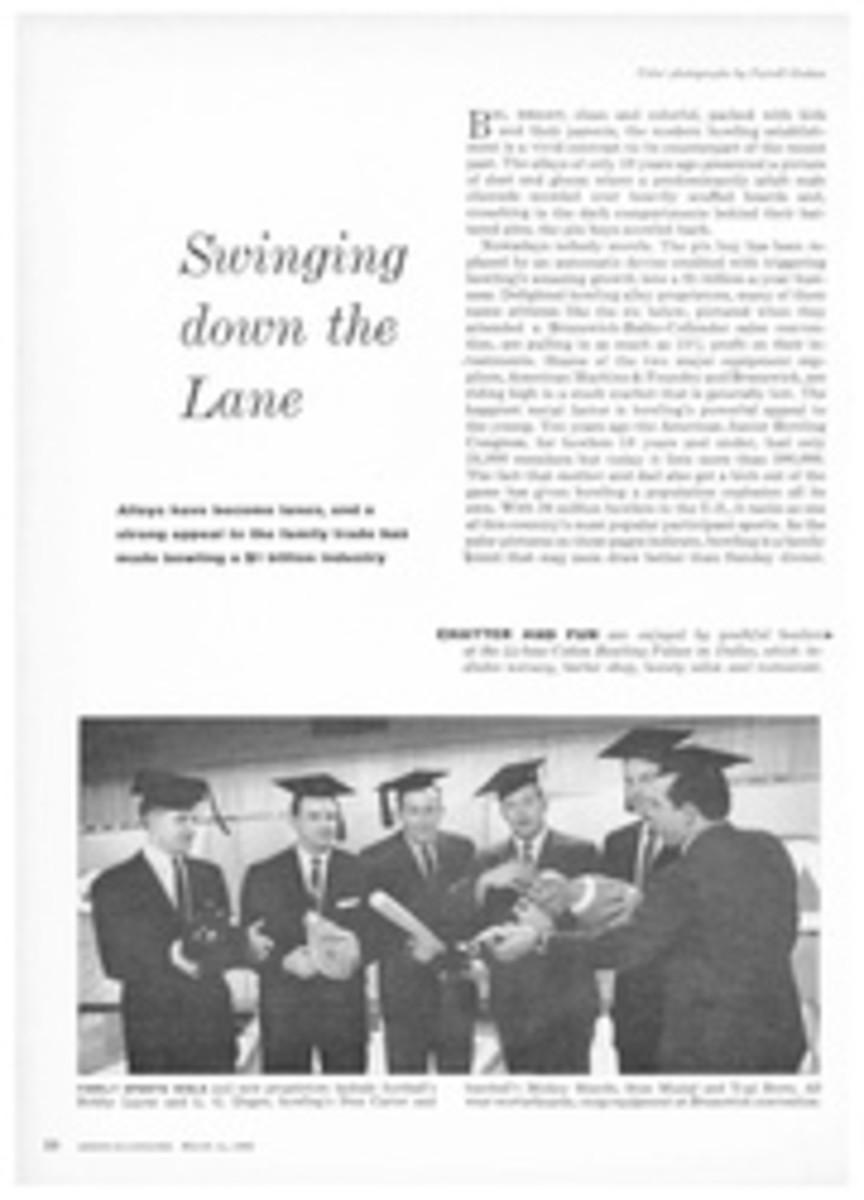
The trout's mouthpiece
If these trout could talk...they might say
•The basic theories of fish management are wrong
•Hatchery trout aren't worth the money
•There is no such thing as a fished-out stream
•Bag limits don't make sense
•Size limits should be abolished
•Most fishermen can't fish
The mute trout shown on the preceding pages—male and female in the first act of the spawning process—have no voices with which to express themselves on the subject of man and his works as they apply to trout. They do, however, have Dr. Paul Robert Needham (below), on whose unique experimental station on Sagehen Creek in the California Sierra these pictures were taken. And with Dr. Needham around, what trout needs to talk?
There is probably no man in the world who knows more about these fish, and certainly no one who can express himself better on the subject. A deceptively gentle-looking, roly-poly zoologist at the University of California, Dr. Needham has spent most of his 58-year lifetime studying trout and developing explosive opinions about them. He believes, and backs up his beliefs with factual research, that most of the methods now practiced in the name of fish management to insure the continued satisfaction of the fisherman's enormous appetite for fish are ridiculous, wasteful and morally degrading.
Dr. Needham does his best to bring the knowledge he has gained to the attention of fishermen, as well as fish and game professionals but, curiously enough, he has found they hate to listen. Fishermen live by fixed beliefs handed down through generations, and their opinions are hard to budge, even when they are faced with indisputable evidence. On Sagehen Creek not long ago, for example, Dr. Needham encountered a disgusted angler, homeward bound after a morning spent in futile lashing of the waters. Dr. Needham listened with a sympathetic smile to the fisherman's complaint that the creek was "fished out." "As it happens," he said, "we're pumping a pool dry downstream. Care to have a look?"
The fisherman did, and while he watched, four graduate students of Dr. Needham's staff pumped out the pool. As the water level sank, the surface was shattered by more and more skittering fish. When they had been carefully netted, anesthetized with Chlorotone, weighed and measured, Dr. Needham turned to the frustrated angler. "That makes 48 fish over six inches," he said, "including a 2½-pound brown trout. Not bad for a fished-out pool, is it?" The fisherman said not a word. It was a pool he had fished in vain that morning.
"You know," said Dr. Needham after the angler had departed, "he saw all those fish, but I don't think he really believed it. He'll probably go home and holler for more fish plants. He'll still say this creek is fished out. But there are more than 8,000 trout over four inches long in Sagehen in the five miles above the highway. And there hasn't been any stocking here since 1951. The plain truth is that, except in very special circumstances, I don't believe a stream can ever be fished out. It's just that most fishermen don't know how to fish."
The statistics bear out Dr. Need-ham's statement. A study by the California Department of Fish and Game showed not long ago that 65% to 75% of all fishermen do not—and apparently cannot—catch any fish at all even when hatchery fish are dumped into the stream right in front of them. Five percent of the fishermen—the real experts—catch 25% of the fish; 10% account for half the total catch.
There are doubtless a great many fishermen who are secretly aware that they belong to the 65% to 75% who never catch anything, but what annoys Dr. Needham is that their solution to the problem is so often simply
to demand that more fish be planted. "Most of the plants die without getting anywhere near a fisherman's creel," he says, "so why the hell do we keep spending millions of dollars on dead fish?"
PRETTY EXPENSIVE HORS D'OEUVRES
Dr. Needham's spirited protest is well founded. Last year 183 million trout were planted in the U.S., including 20 million catchable trout between six and eight inches long, costing $4,300,000. The Sport Fishing Institute of Washington, D.C. estimates that 30% of the planted trout are probably recovered by fishermen. "These artificial fish," Dr. Needham says, "probably furnish some food for wild trout—and there are studies indicating that between 75% and 85% of all trout caught are wild trout—but at 89¢ a pound, which is what it costs to stock and raise them, they figure out as pretty expensive hors d'oeuvres. Actually, hatchery-bred trout are liver-fed, inbred mongrels. They cannot compete with wild fish in a mountain stream. I've watched them come up against wild fish, and the wild trout push them around unmercifully."
Dr. Needham has watched trout being pushed around by other trout—right in their own waters. A doctor of fisheries who graduated from Cornell in 1928 after a childhood and youth spent mostly in watching fish, he served variously as a teacher at the University of Rochester, an official with the Bureau of Fisheries in New Jersey and later California and as Chief of Fisheries in Oregon before settling down as professor of zoology at the University of California in 1949. There, when the university acquired the use of a section of national forest which included Sagehen Creek, he put into execution a project which had long simmered in his mind. "I felt," le says today, "that I could best serve the university and the state by developing an experimental field station where we could get right in and deep with the fish."
At Sagehen he and his students constructed a unique observation tank which has been in active use ever since. It is a steel box, six feet long, four feet wide and five feet deep. It sits right in the creek, and the observer, who enters from the top and lies on an air mattress, can look out through Plexiglas windows and see everything that is going on from a fish eye's point of view.
In "the deep freeze," as the box is called by students who have spent many hours in it studying the life of a trout in winter, some myths have been exploded, some new theories substantiated. For example:
•Trout feed all winter long, even when the water is at the freezing point. Stone flies, caddis, May flies and midges are available on the bottom in abundance for food.
•Trout in winter are seriously endangered by ice. Anchor ice, building up from the bottom at the upstream base of rocks, sometimes temporarily dams a stream, cutting off the fish, which suffocate. Frazil ice, tiny spearhead crystals which form in the water, plug the gills of fish, killing them. Dr. Needham knew that in winter 62% of trout under four inches long died; that the mortality rate of trout more than four inches long was even higher, at 80%. Now he knows why.
•Beaver dams are beneficial to trout in forest streams like Sagehen Creek; they spread the water, deepen the aquatic habitat, increase the standing crop of bottom foods, ameliorate the severe conditions of winter. Dr. Needham thinks there should be many more beaver dams on trout streams.
•Trout have a highly developed sense of territorial rights, which has an important bearing on the fate of planted trout. They will defend their particular water against intruders. Thus, when hatchery trout are dumped into a stream, the native wild trout will bar choice food spots to the hapless newcomers, keeping them on the move constantly. Result: those that do not live long enough to starve to death die of exhaustion. Wild trout, similarly transplanted to a strange stream, had the same tough time but, being stronger, were able to survive until they had established themselves.
DOWN WITH "PUT AND TAKE"
These and other observations made in the "deep freeze" confirmed, in some cases, what had hitherto been only surmised (it was the late Dr. Richard B. Miller of the University of Alberta, for instance, who first suspected that hatchery trout were often hounded to death by native fish). They have also led Dr. Needham to reject most of the remedies suggested or employed to prevent "overfishing." He rejects and condemns "put and take" planting except in congested urban areas.
"Many streams being planted today should not be stocked at all," Needham says. "Natural propagation will, in most cases, carry the entire burden of angling pressure."
As for agitation to reduce bag limits, he points out: "Since only the experts ever get a limit of fish, the only effect of reducing the bag limit would be to reduce the number of fish taken by good fishermen. Bad fishermen would not benefit."
He is also against the school which advocates minimum size limits for trout. "A six-inch limit means that you have to wait until the second year to catch them," he says. "Meanwhile up to 85% will be killed by winter conditions. Why not let the angler catch them as soon as they are big enough to take a hook?"
In the face of what he considers sure proof of the failure of the put-and-take theory of stream planting, Dr. Needham would like to see something constructive done to improve the conditions of our streams—since wild fish, naturally propagated, are the ones that most often end up in the pan. "All any animal needs for success is food, shelter and suitable conditions for reproduction," he says. "If we can—and We can—provide these conditions for trout, we will never have to worry about a shortage of fish. If we provide the right conditions the fish will utilize their habitat to the fullest—living right up to all the board and room there is. We don't give them credit for their efficiency in using their environment."
At present, Dr. Needham says, three-quarters of the money available for improving fishing is spent on hatching and planting. It is high time, he believes, for a re-allocation of these funds, high time to start spending some of the money to improve the streams.
Fortunately, the methods of "helping" streams are known. For example, Needham says, we can improve spawning beds of streams by the simple expedient of dumping in gravels of the proper size. The Sagehen Creek "laboratory" has proved the worth of planting beaver on streams similar to Sagehen with fabulous results in increased number of trout. Long stretches of shallow riffles can be built by rock or log dams to form productive pools. "We know what trout eat," Needham says, "and can introduce their food. The air-borne insects will transport themselves to the new waters to deposit their eggs. If the pools can be produced, the fish will be there." And that, after all, is what everybody wants, including the trout.
PHOTO
ROMAN VISHNIAC
PHOTO
A HAPPY SCIENTIST, Dr. Needham wades through Sagehen Creek in search of trout.

